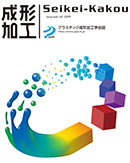
- |<
- <
- 1
- >
- >|
-
2018 Volume 30 Issue 4 Pages Index4_1-Index4_2
Published: March 20, 2018
Released on J-STAGE: August 25, 2020
JOURNAL FREE ACCESSDownload PDF (638K)
-
Yasuhiro Ishikawa2018 Volume 30 Issue 4 Pages 137
Published: March 20, 2018
Released on J-STAGE: August 25, 2020
JOURNAL FREE ACCESSDownload PDF (847K)
-
Ken Kojio2018 Volume 30 Issue 4 Pages 138-141
Published: March 20, 2018
Released on J-STAGE: August 25, 2020
JOURNAL FREE ACCESSDownload PDF (6608K) -
Kenzo Fukumori2018 Volume 30 Issue 4 Pages 142-145
Published: March 20, 2018
Released on J-STAGE: August 25, 2020
JOURNAL FREE ACCESSDownload PDF (8458K) -
Ken Nakajima, Xiaobin Liang2018 Volume 30 Issue 4 Pages 146-149
Published: March 20, 2018
Released on J-STAGE: August 25, 2020
JOURNAL FREE ACCESSDownload PDF (2080K) -
Naoya Amino2018 Volume 30 Issue 4 Pages 150-154
Published: March 20, 2018
Released on J-STAGE: August 25, 2020
JOURNAL FREE ACCESSDownload PDF (6676K)
-
Noriyuki Fujii, Fumiaki Baba2018 Volume 30 Issue 4 Pages 155-157
Published: March 20, 2018
Released on J-STAGE: August 25, 2020
JOURNAL FREE ACCESSDownload PDF (1880K)
-
Kohei Arakawa2018 Volume 30 Issue 4 Pages 158-159
Published: March 20, 2018
Released on J-STAGE: August 25, 2020
JOURNAL FREE ACCESSDownload PDF (1170K)
-
Kentaro Taki2018 Volume 30 Issue 4 Pages 160-161
Published: March 20, 2018
Released on J-STAGE: August 25, 2020
JOURNAL FREE ACCESSDownload PDF (5091K)
-
Hideki Tomiyama, Yohei Fukuzawa, Daisuke Fukuzawa2018 Volume 30 Issue 4 Pages 162-169
Published: March 20, 2018
Released on J-STAGE: August 25, 2020
JOURNAL FREE ACCESSDeep learning using an artificial intelligence algorithm was carried out in order to automatically determine the screw configuration of an intermeshing co-rotating twin screw extruder, and a system development was conducted to obtain an optimum output value for the specified extrusion conditions from the learning results. In deep learning, supervised learning was adopted that gives extrusion conditions and machinery configuration to the input layer and sets the analysis results and experiment results to the output layer. After performing the deep learning, judgment processing was carried out under the conditions of complete melting extrusion at just 200℃ as designation conditions, and four kinds of screw design were outputted. As a result of experiment verification of these four screws, it was confirmed that they satisfy the specified value with high accuracy. This suggested that it is possible to determine the screw configuration with deep experience and expertise by utilizing the artificial intelligence algorithm.
View full abstractDownload PDF (1175K) -
Masao Tomioka, Takeshi Ishikawa, Akira Inoue, Tatsuya Tanaka2018 Volume 30 Issue 4 Pages 170-177
Published: March 20, 2018
Released on J-STAGE: August 25, 2020
JOURNAL FREE ACCESSHybridizations of materials or molding methods are effective tools as high-speed and low-cost molding technologies of CFRTP, and a hybrid injection molding system is one of them. This study investigated the influence of molding conditions in the hybrid injection molding on the interfacial adhesion between inserted material and injection-molded material by using temperature and pressure sensors in the mold. It was found that “temperature rise of the injection-resin”, “increase in the injection rate” and “pre-heating of the insert-material” are effective for improving the interfacial adhesion. Regarding the improvement of the interfacial adhesion due to “temperature rise of the injection-resin” and “increase in the injection rate”, the rise in the interface temperature during adhesion had a dominant influence on the adhesion. On the other hand, the pressure did not contribute to the interfacial adhesion. Moreover, it was assumed that “pre-heating of the insert-material” improves the adhesion with anchor effect due to roughening of the insert-material surface by heating.
View full abstractDownload PDF (944K)
- |<
- <
- 1
- >
- >|